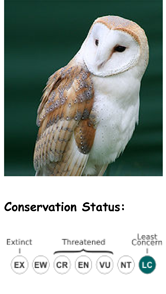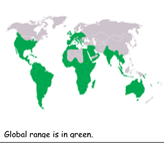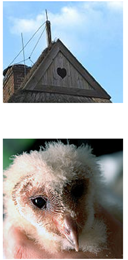Learn About Barn Owls
The Barn Owl (Tyto alba) is the most widely distributed species of owl, and one of the most widespread of all birds. They are found almost anywhere in the world outside polar and desert regions.
The Barn Owl is a pale, long-winged, long-legged owl with a short square tail. Depending on subspecies, it measures between 25 and 45 cm in overall length, with a wingspan of about 75 to 100 cm.
Its head and upper parts are a mixture of buff and grey (especially on the forehead and back) feathers in most subspecies. All have fine black-and-white speckles
The heart-shaped face is usually bright white. The underparts vary from white to reddish buff among the subspecies, and are either mostly un-patterned or bear a varying amount of tiny blackish-brown speckles.
Contrary to popular belief, it does not hoot. It instead produces the characteristic shree scream, ear-shattering at close range. It can hiss like a snake, and when captured or cornered, it throws itself on its back and flails with sharp-taloned feet, making for an effective defence.
This is a bird of open country such as farmland or grassland. This owl prefers to hunt along the edges of woods. It has an effortless wavering flight as it quarters pastures or similar hunting grounds. Like most owls, the Barn Owl flies silently; tiny serrations on the leading edges of its flight feathers help to break up the flow of air over its wings, thereby reducing turbulence and the noise that accompanies it.
The Barn Owl has acute hearing, with ears placed asymmetrically for improved detection of sound position and distance, and it does not require sight to hunt. Hunting nocturnally or crepuscularly, it can target and dive down, penetrating it talons through snow, grass or brush to seize rodents with deadly accuracy. Compared to other owls of similar size, the Barn Owl has a much higher metabolic rate, requiring relatively more food. Pound for pound, Barn Owls consume more rodents than possibly any other creature. Studies have shown that an individual Barn Owl may eat one or more rodents per night; a nesting pair and their young can eat more than 1,000 rodents per year! This makes the Barn Owl one of the most economically valuable wildlife animals to farmers. Farmers often find these owls more effective than poison in keeping down rodent pests, and they can encourage Barn Owl habitation by providing nest sites.
The Barn Owl builds a nest of sorts, but unlike in typical owls it is just a scrape in any unsorted debris as has assembled in a hollow with narrow entrance. Typical nest sites include tree stumps and cliff crevices, but these owls will readily nest in attics, vacant and ruined buildings, and even wells, chimneys, hunting blinds and similar locations. The usual clutch consists of roughly half a dozen eggs, but may be as small as 2.
Predators of the Barn Owl include large American opossums, the Common Raccoon, and similar carnivorous mammals, as well as large raptors such as hawks, eagles, and other owls such as Great Horned Owl and the Eurasian Eagle-owl. Some fall also victim to large snakes, but the biggest threats are habitat loss and humans and their pets (in particular house or feral cats).
Barn Owls are relatively common throughout most of their range. However, locally severe declines from organochlorine (e.g. DDT) poisoning in the mid-20th century and rodenticides in the late 20th century have affected some populations. In Canada, Barn Owls are listed as endangered species. In Southern Ontario, the Barn Owl is critically endangered with only one breeding pair remaining in the wild.

Scientific Classification:
- Kingdom: Animalia
- Phylum: Chordata
- Class: Aves
- Subclass: Neornithes
- Infraclass: Neognathae
- Superorder: Neoaves
- Order: Strigiformes
- Family: Tytonidae
- Subfamily: Tytoninae
- Genus: Tyto
- Species: T. alba


References: * Álamo Tavío, Manuel (1975): Aves de Fuerteventura en peligro de extinción [“Endangered Birds of Fuerteventura”]. In: Asociación Canaria para Defensa de la Naturaleza (ed.): Aves y plantas de Fuerteventura en peligro de extinción: 10-32. Las Palmas de Gran Canaria.

